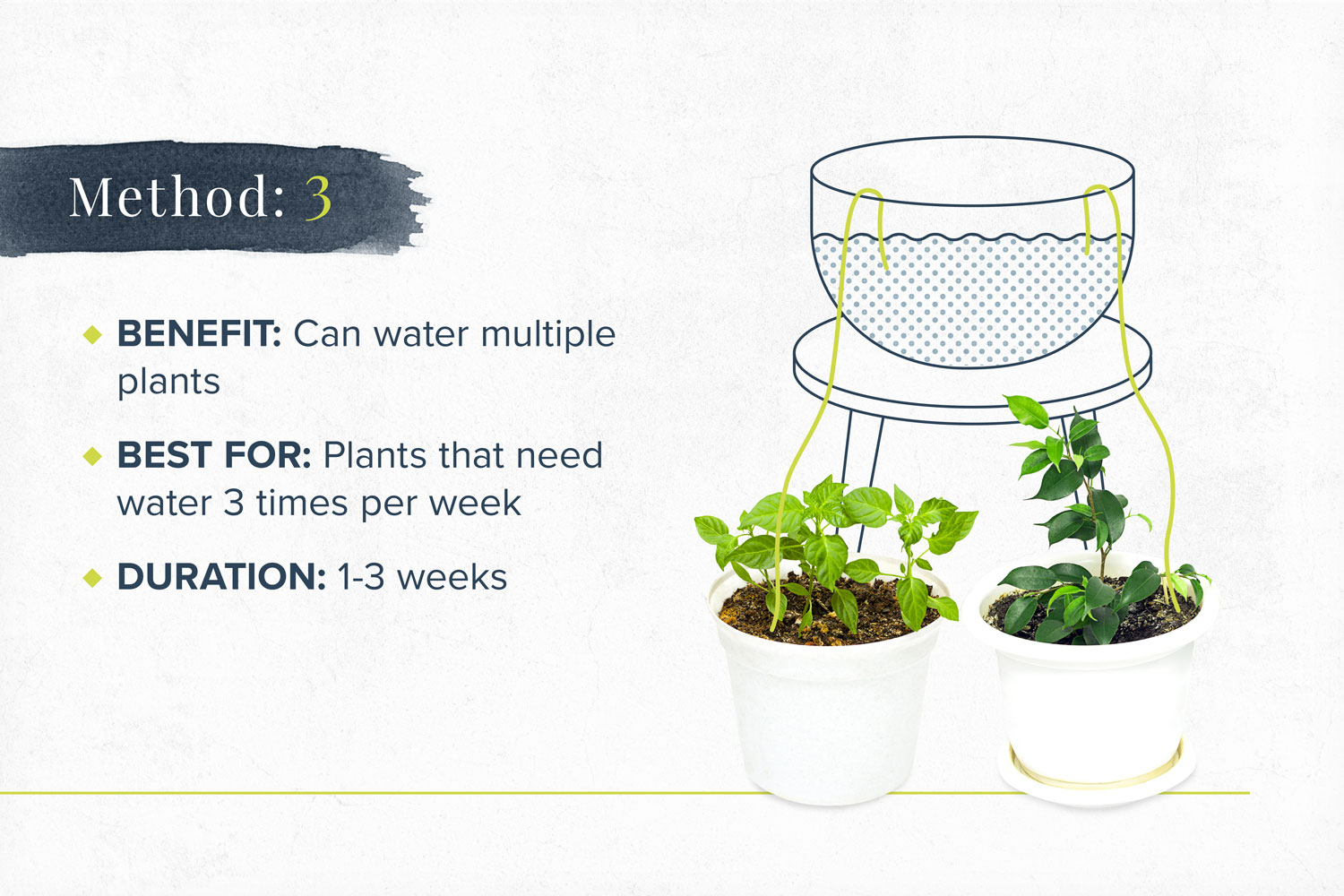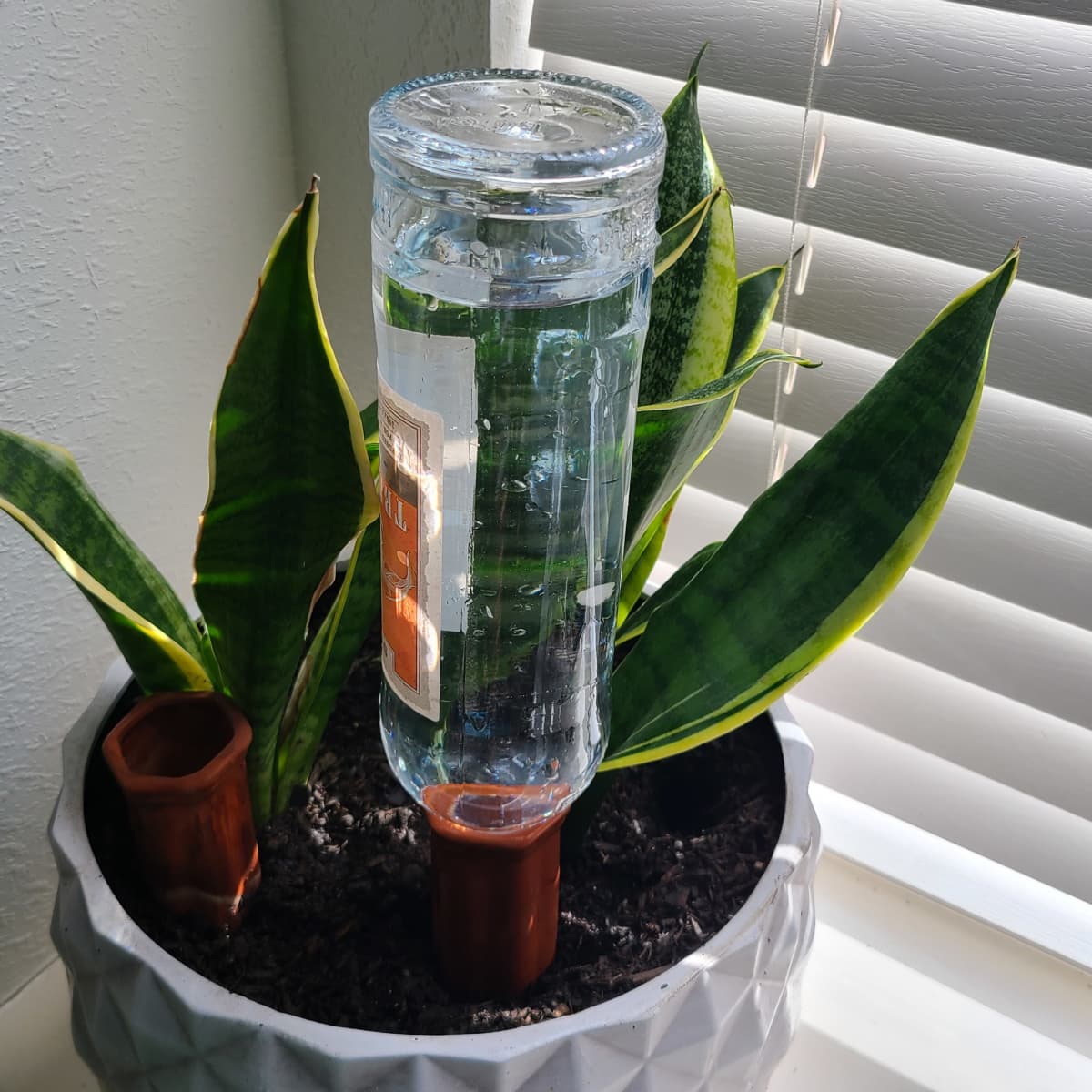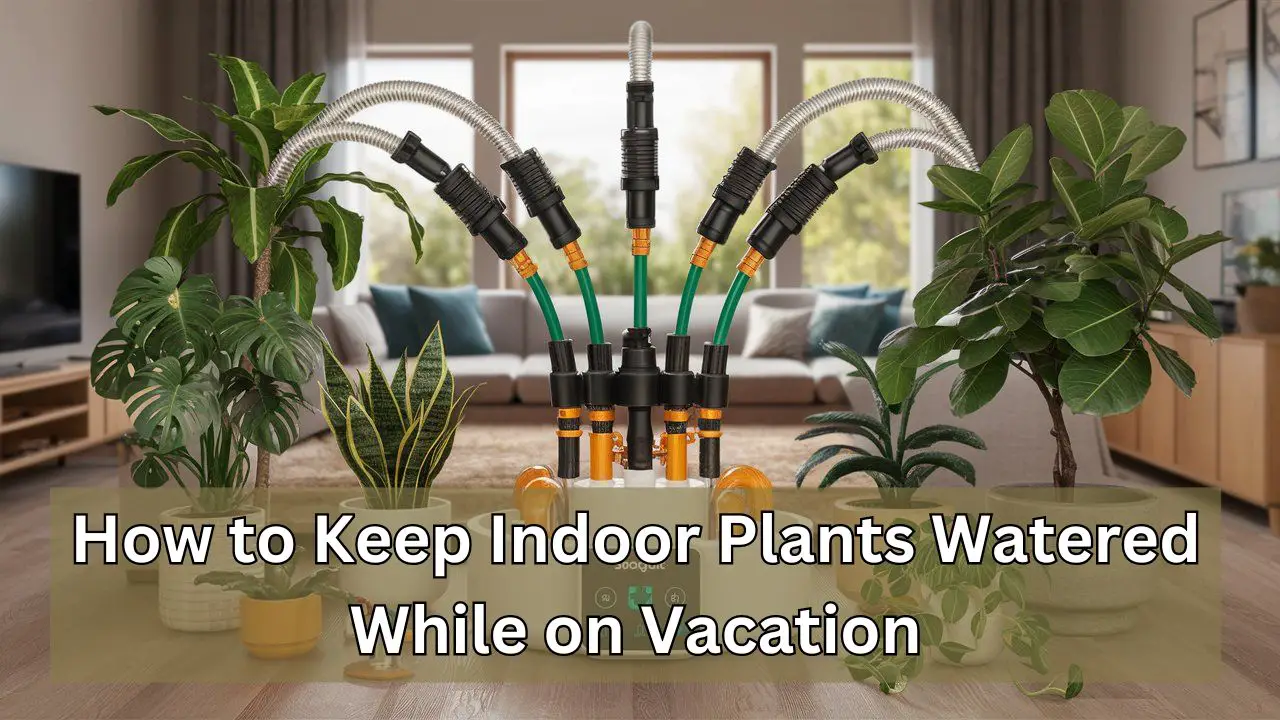To keep indoor plants watered while on vacation, use self-watering systems or ask a friend for help. Ensure plants receive enough moisture.
Going on vacation can be stressful for plant owners. Ensuring your indoor plants stay healthy and hydrated during your absence is crucial. One effective method is using self-watering systems like wicking pots or water globes. These tools provide a steady water supply to your plants.
Another option is asking a reliable friend or neighbor to water your plants. Preparing your plants before leaving, such as moving them to a cooler area or grouping them together, can help retain moisture. Proper planning ensures your plants thrive while you enjoy a worry-free vacation.

Credit: www.proflowers.com
Introduction To Vacation Plant Care
Planning a vacation is exciting. But you worry about your plants at home. Indoor plants need regular care. They need water, light, and love. How do you keep them healthy while you’re away? This guide will help you learn simple tricks.
The Dilemma Of Plant Owners
Plant owners face a big dilemma. They worry about their plants while away. They fear their plants will dry out. This fear can spoil vacation fun. But don’t worry, there are solutions.
Importance Of Consistent Watering
Consistent watering is vital. Plants need water to grow. They need it to stay green. A lack of water can harm them. It can make them weak and yellow. Regular watering keeps them strong.
| Watering Tip | Benefit |
|---|---|
| Use a self-watering pot | Ensures steady water supply |
| Group plants together | Creates a humid micro-environment |
| Place mulch on soil | Reduces water evaporation |
- Self-watering pots: These pots are life-savers. They provide water slowly.
- Grouping plants: Plants help each other. They create a humid zone.
- Using mulch: Mulch keeps soil wet. It stops water from escaping.
- Water your plants well before you leave.
- Move them away from direct sunlight.
- Use the tips listed above to ensure they stay hydrated.
Self-watering Solutions
Keeping indoor plants watered during your vacation can be challenging. Self-watering solutions make this task easier. These systems ensure your plants stay hydrated. They are convenient and efficient. Here are two effective self-watering methods:
Commercial Self-watering Stakes
Commercial self-watering stakes are easy to use. They are widely available in garden stores. These stakes work by releasing water slowly. This keeps the soil moist for several days. Here are some features:
- Easy to install
- Low maintenance
- Reliable watering
To use them, follow these steps:
- Fill a bottle with water.
- Attach the stake to the bottle.
- Insert the stake into the soil.
These stakes come in various sizes. Choose one that fits your plant’s needs. They are perfect for short vacations.
Diy Wick System
The DIY wick system is simple and cost-effective. You can make it with common household items. This method uses a wick to draw water from a container. It keeps the soil moist. Here’s what you need:
| Item | Quantity |
|---|---|
| Cotton rope or string | 1 piece per plant |
| Water container | 1 per plant |
Follow these steps to set up a DIY wick system:
- Cut a piece of cotton rope or string.
- Place one end in the water container.
- Insert the other end into the soil.
Ensure the rope touches the bottom of the container. Place the container higher than the plant pot. This helps the water to flow properly.
Both methods help keep your plants healthy. They are great for short trips and long vacations.
Water Reservoir Techniques
Going on vacation but worried about your indoor plants? Water reservoir techniques can help! These methods ensure your plants stay hydrated. Let’s explore some easy and effective ways to keep your plants watered while you enjoy your vacation.
Using Water Bottles
One simple way to water your plants is by using water bottles. This method is easy and effective for small to medium-sized plants.
- Take a plastic water bottle.
- Fill it with water.
- Make small holes in the cap.
- Turn the bottle upside down.
- Insert it into the soil.
The water will slowly trickle into the soil. This keeps the plants hydrated for days.
Creating A Mini Greenhouse
Create a mini greenhouse to keep the soil moist for a longer time. This method is perfect for plants that need high humidity.
- Take a clear plastic bag.
- Cover the plant with the bag.
- Ensure the bag does not touch the leaves.
- Seal the bag at the base of the plant.
The mini greenhouse traps moisture and creates a humid environment. This reduces the need for frequent watering.
Using these water reservoir techniques can keep your plants healthy while you are away. Try these methods and enjoy your vacation without worrying about your indoor plants!
Plant Bath Method
Keeping indoor plants watered during a vacation can be challenging. The Plant Bath Method offers a simple solution. This method uses a water-filled basin to keep plants hydrated. Let’s explore how to set up a plant bath and some safety tips for this technique.
How To Set Up A Plant Bath
Setting up a plant bath is easy and effective. Follow these steps:
- Choose a basin: Find a large basin or bathtub.
- Fill with water: Fill the basin with a few inches of water.
- Place a towel: Lay a towel at the bottom to prevent slips.
- Arrange the plants: Put your potted plants in the basin.
- Check drainage: Ensure pots have good drainage holes.
Safety Tips For Plant Bathing
Follow these tips to keep your plants safe:
- Avoid overwatering: Do not fill the basin too high.
- Monitor sunlight: Ensure the area gets indirect light.
- Check for pests: Inspect plants for pests before bathing.
- Use appropriate pots: Ensure pots are suitable for water baths.
By using the Plant Bath Method, you can ensure your plants stay hydrated. This simple setup provides peace of mind while you’re away.
Capillary Matting For Moisture
Capillary matting is a fantastic way to keep your indoor plants hydrated while you are on vacation. This method uses special mats that draw water up through their fibers, providing a steady moisture supply to your plants. Here’s how to set it up and the pros and cons of using capillary matting.
Setting Up A Capillary Mat
Follow these simple steps to set up a capillary mat:
- Choose a Tray: Select a shallow tray or container.
- Place the Mat: Lay the capillary mat inside the tray.
- Add Water: Pour water into the tray until the mat is fully soaked.
- Position the Plants: Place your potted plants on top of the mat.
Ensure that the pots have drainage holes to allow water to wick up from the mat.
Pros And Cons Of Capillary Matting
| Pros | Cons |
|---|---|
|
|
Capillary matting can be a lifesaver for plant parents. Follow these steps, and your plants will stay happy and hydrated while you enjoy your vacation.

Credit: www.cnet.com
Grouping Plants For Humidity
Keeping indoor plants healthy while on vacation can be challenging. Grouping plants together can help maintain their humidity levels. This method benefits both the plants and the overall indoor environment.
Benefits Of Plant Grouping
Grouping plants has several advantages. Here are some key benefits:
- Increased humidity: Plants release moisture through transpiration. When grouped, this moisture helps maintain a higher humidity level.
- Reduced water loss: Higher humidity means less water evaporation from the soil.
- Better growth: Consistent humidity levels support healthy plant growth.
- Improved aesthetics: Grouped plants create a lush, green corner in your home.
How To Group Different Plant Types
Properly grouping different plant types requires some planning. Follow these steps to ensure each plant thrives:
- Select plants with similar humidity needs: Group plants that require similar moisture levels. This prevents overwatering or underwatering.
- Consider plant size: Place taller plants at the back and shorter ones at the front. This ensures each plant gets enough light.
- Use trays with pebbles: Place grouped plants on trays filled with pebbles and water. This creates a humid microclimate.
- Monitor air circulation: Ensure good airflow around the plants. This prevents mold and mildew growth.
Here’s a quick reference table for grouping common indoor plants:
| Plant Type | Humidity Needs | Ideal Grouping |
|---|---|---|
| Ferns | High | Group with other high-humidity plants like Calatheas |
| Succulents | Low | Group with other low-humidity plants like Cacti |
| Peace Lilies | Medium | Group with medium-humidity plants like Spider Plants |
Mulching For Moisture Retention
Keeping your indoor plants watered while on vacation can be challenging. One effective method is mulching. Mulching helps retain moisture in the soil, reducing the frequency of watering.
Choosing The Right Mulch
Selecting the best mulch is crucial. Different types of mulch offer various benefits.
- Organic Mulch: Includes materials like bark, leaves, and straw. These decompose over time, enriching the soil.
- Inorganic Mulch: Consists of gravel, pebbles, and stones. These do not decompose but still help retain moisture.
Organic mulch is often preferred for indoor plants. It adds nutrients and improves soil health.
Application Techniques For Indoor Plants
Applying mulch correctly is essential to its effectiveness. Follow these steps:
- Prepare the Soil: Ensure the soil is moist before applying mulch.
- Layering: Add a 1-2 inch layer of mulch on the soil surface. This is sufficient for most indoor plants.
- Avoid the Stem: Keep mulch away from the plant stem to prevent rot.
Check the mulch regularly. Refresh it if it appears dry or compacted.
| Type of Mulch | Benefits |
|---|---|
| Organic | Improves soil health and retains moisture |
| Inorganic | Long-lasting and helps retain moisture |
Using mulch is a simple way to keep your indoor plants hydrated. It reduces the need for frequent watering and enriches the soil.
Tech Gadgets For Watering
Going on vacation shouldn’t mean coming back to wilted indoor plants. Tech gadgets can help keep your plants well-watered. These smart tools ensure your plants thrive even when you’re away.
Electronic Watering Systems
Electronic watering systems are a game-changer for plant lovers. These systems deliver water at scheduled times.
- Automatic Drip Irrigation Kits: These kits have timers and adjustable drippers. They provide a steady water supply.
- Self-Watering Pots: These pots have a built-in water reservoir. They release water as needed.
- Wi-Fi Controlled Systems: Control these systems from your phone. Adjust settings from anywhere in the world.
| Product | Features |
|---|---|
| Automatic Drip Kit | Timers, adjustable drippers, steady water flow |
| Self-Watering Pot | Built-in reservoir, releases water as needed |
| Wi-Fi Watering System | Remote control, adjust settings from anywhere |
Smart Plant Sensors And Apps
Smart plant sensors monitor soil moisture levels. They help you know when your plants need water.
- Moisture Sensors: Insert these sensors into the soil. They send data to your phone.
- Light and Temperature Sensors: Some sensors also measure light and temperature. This ensures optimal growing conditions.
- Connected Apps: Use apps to track plant health. They provide watering reminders and tips.
Popular Apps include:
- PlantSnap: Identifies plants and gives care tips.
- Happy Plant: Reminds you when to water.
- Florish: Tracks plant health and gives recommendations.
Pre-vacation Plant Care Checklist
Planning a trip? Worrying about your beloved indoor plants? Our Pre-Vacation Plant Care Checklist ensures they stay healthy and hydrated while you’re away. Follow these simple steps to keep your plants thriving even when you’re not around.
Pruning And General Maintenance
Start by pruning your plants. Remove any dead or yellowing leaves. This helps the plant focus its energy on healthy growth. Check for pests and treat accordingly. Use a mild insecticidal soap if needed. Clean the leaves with a damp cloth to remove dust. This allows for better photosynthesis.
Inspect the soil. Ensure it drains well. If it’s compacted, gently aerate it. This helps the roots breathe. Also, consider repotting if the plant has outgrown its current pot. Use a pot with drainage holes.
Final Watering And Feeding
Water your plants thoroughly. Ensure the water reaches the roots. Avoid overwatering. Check the soil moisture before you leave. If it’s too wet, it can cause root rot.
Feed your plants with a balanced fertilizer. Follow the instructions on the package. This gives them the nutrients they need while you’re away. For longer trips, use slow-release fertilizers. They provide a steady supply of nutrients.
Consider using self-watering systems. These can be a lifesaver. Options include self-watering pots, wicking systems, or even water globes. Choose one that suits your plants’ needs.
Group plants with similar water needs together. This makes it easier to manage their care. Place them in a location with indirect light. Too much direct sunlight can dry them out quickly.
| Task | Details |
|---|---|
| Pruning | Remove dead leaves, check for pests, clean leaves. |
| Soil Check | Ensure well-draining, aerate if compacted, consider repotting. |
| Watering | Thoroughly water, avoid overwatering, check soil moisture. |
| Feeding | Use balanced fertilizer, consider slow-release for longer trips. |
| Self-Watering Systems | Use self-watering pots, wicking systems, or water globes. |
| Grouping | Group plants with similar needs, place in indirect light. |
Common Mistakes To Avoid
Going on vacation should be a relaxing time. But what about your indoor plants? Ensuring they stay healthy while you’re away can be tricky. Avoid these common mistakes to keep your plants thriving.
Overwatering Before Leaving
Overwatering is a common mistake. Many people think soaking plants will keep them hydrated. This can actually harm your plants. Too much water can lead to root rot.
Instead, water your plants just enough. Ensure the soil is moist but not soggy. Use a moisture meter to check soil levels. This helps in providing the right amount of water.
Ignoring Plant-specific Needs
Different plants have different needs. Some plants require more water, others less. Ignoring this can cause problems.
Here’s a simple table to help:
| Plant Type | Watering Frequency |
|---|---|
| Cacti | Once every 2 weeks |
| Ferns | Once a week |
| Succulents | Once a week |
Knowing your plant’s needs is crucial. This ensures they get the right care. Group plants with similar needs together. This makes watering them easier and more efficient.
By avoiding these common mistakes, your indoor plants will stay healthy. Enjoy your vacation without worry!
Conclusion: Peace Of Mind For Plant Parents
Leaving your beloved indoor plants while on vacation can be stressful. With the right methods, your plants will stay healthy and hydrated. Enjoy your trip knowing your green friends are well cared for.
Recap Of Effective Methods
Here is a quick recap of the most effective ways to water plants while you’re away:
- Self-watering pots: These pots have a built-in water reservoir.
- Watering globes: These devices slowly release water into the soil.
- Capillary mats: Place these mats under your pots. They wick water to the plants.
- DIY drip system: Use a plastic bottle to slowly drip water into the soil.
- Grouping plants: Group plants together to create a humid environment.
Encouragement For Worry-free Travel
Travel with peace of mind knowing your plants are safe. You’ve set up effective watering methods. Your indoor plants will thrive even in your absence.
Enjoy your vacation! Your plants will welcome you back with their lush and healthy leaves.

Credit: dengarden.com
Frequently Asked Questions
How Long Can Indoor Plants Go Without Water?
Indoor plants can typically go 1-3 weeks without water. The duration depends on the plant type and indoor conditions.
How To Make An Automatic Plant Watering System?
To create an automatic plant watering system, use a timer, water pump, tubing, and moisture sensors. Connect components, set timer, and adjust for plant needs.
How To Make A Self-watering Plant System?
Create a self-watering plant system by using a plastic bottle, string, and soil. Cut the bottle, insert the string, and fill it with water. Place soil and plant on top.
How Do You Water Indoor Plants Without Water Everywhere?
Use a watering can with a narrow spout. Place a saucer under each pot to catch excess water. Water slowly and evenly.
Conclusion
Keeping indoor plants hydrated during vacation is easy with proper planning. Use self-watering systems or enlist help from a friend. Ensure your plants receive enough light and nutrients. With these tips, your plants will thrive while you’re away. Enjoy your vacation, knowing your green friends are well cared for.

My mission is to help you bring the beauty of nature indoors with expert advice, detailed plant care guides, and creative design ideas.




